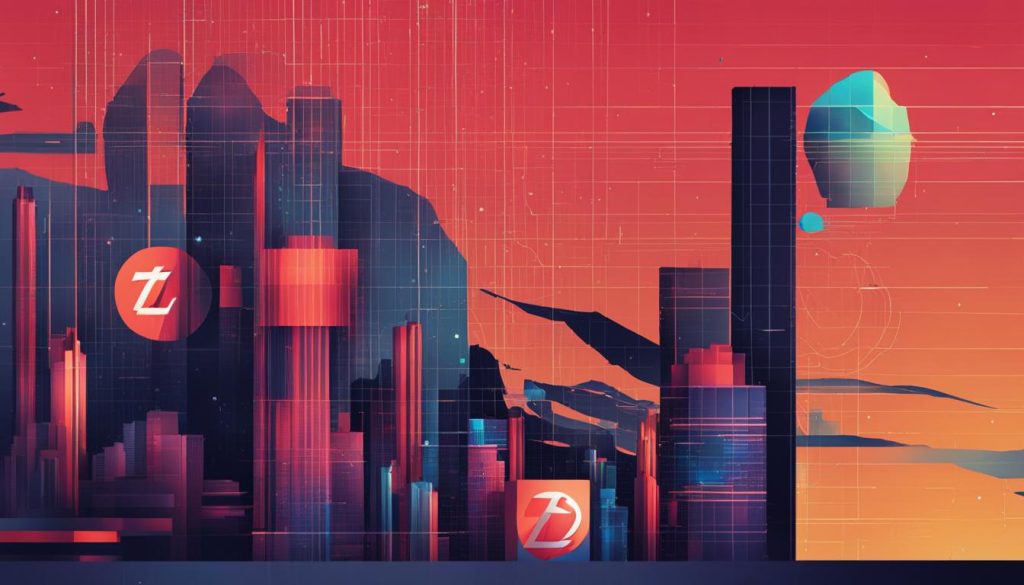Litecoin, a digital currency created in 2011, is a pioneering cryptocurrency that operates on a blockchain similar to Bitcoin. It was developed to address concerns about Bitcoin’s centralization and offers faster transaction processing times. Using the unique Scrypt algorithm, Litecoin has gained recognition as the “silver to Bitcoin’s gold.” It has become a popular choice for cryptocurrency enthusiasts and investors due to its faster block generation, lower transaction fees, and ongoing innovations.
Key Takeaways:
- Litecoin is a digital currency that operates on a blockchain similar to Bitcoin.
- It was created in 2011 to offer faster transaction processing times and address concerns about Bitcoin’s centralization.
- The Scrypt algorithm is used by Litecoin, making it faster and more efficient than Bitcoin.
- Litecoin has gained recognition as the “silver to Bitcoin’s gold” and offers several advantages, including faster block generation and lower transaction fees.
- Litecoin’s ongoing innovations and strong community make it a popular choice among cryptocurrency enthusiasts and investors.
History and Development of Litecoin
Led by creator Charlie Lee, Litecoin emerged in 2011 as one of the early altcoins in the cryptocurrency space. Lee, a former Google engineer, sought to address concerns surrounding Bitcoin, particularly its transaction speeds and mining monopolies. As an open-source project, Litecoin became a platform for testing innovative ideas that would later impact Bitcoin and the broader blockchain ecosystem.
What sets Litecoin apart from Bitcoin and other cryptocurrencies is its use of the Scrypt algorithm for mining. This algorithm enables faster block generation and transaction processing compared to Bitcoin’s SHA-256 algorithm, making Litecoin more efficient for everyday use.
Litecoin’s development and technology have fostered its reputation as a secure, peer-to-peer payment network. With its lower fees and faster transaction speeds, Litecoin has gained significant recognition as a viable alternative to Bitcoin, attracting a dedicated community and expanding adoption.

Key Points:
- Litecoin was created in 2011 by Charlie Lee, a former Google engineer.
- It was developed as an altcoin to address Bitcoin’s transaction speed and mining monopolies.
- Litecoin uses the Scrypt algorithm for mining, enabling faster block generation and transaction processing.
- Litecoin’s development and technology have positioned it as a secure, peer-to-peer payment network.
- The cryptocurrency has gained recognition and adoption as a viable alternative to Bitcoin.
Table: Litecoin vs. Bitcoin Comparison
| Litecoin | Bitcoin | |
|---|---|---|
| Creator | Charlie Lee | Satoshi Nakamoto |
| Year Created | 2011 | 2009 |
| Algorithm | Scrypt | SHA-256 |
| Transaction Speeds | Faster | Slower |
| Transaction Fees | Lower | Higher |
| Supply | 84 million coins | 21 million coins |
How Does Litecoin Work?
Litecoin operates on a proof-of-work consensus mechanism, similar to Bitcoin. Miners use a hashing algorithm called Scrypt to validate transactions and secure the Litecoin network. This algorithm allows for faster transaction speeds compared to Bitcoin’s SHA-256 algorithm. Miners solve complex mathematical problems to earn the right to record new transactions on the Litecoin blockchain. As a reward for their efforts, miners receive newly generated Litecoin coins.
The supply of Litecoin is capped at 84 million coins, ensuring scarcity and contributing to its value. To maintain the controlled supply, the block reward for miners is halved at regular intervals. This process, known as halving, helps control the rate of coin creation and maintains the integrity of the cryptocurrency. Currently, the block reward for Litecoin miners is 6.25 LTC per block. The next halving event is expected to occur in 2023.
Litecoin’s blockchain serves as a decentralized ledger that records all transactions and ensures their integrity. It allows for secure and transparent transactions, as every transaction is verified and stored on the blockchain. The decentralized nature of the blockchain also prevents any single entity from controlling the network or altering transaction records. Transactions made with Litecoin are broadcasted to the network and confirmed by multiple nodes, providing security and reliability.
Table: Differences Between Litecoin and Bitcoin
| Feature | Litecoin | Bitcoin |
|---|---|---|
| Hashing Algorithm | Scrypt | SHA-256 |
| Transaction Speeds | Faster | Slower |
| Transaction Fees | Lower | Higher |
| Maximum Supply | 84 million coins | 21 million coins |
The table above highlights some key differences between Litecoin and Bitcoin. Litecoin’s use of the Scrypt algorithm allows for faster transaction speeds and lower transaction fees compared to Bitcoin. Additionally, Litecoin has a maximum supply of 84 million coins, four times that of Bitcoin’s 21 million coins. These differences make Litecoin more suitable for everyday transactions, while Bitcoin is often seen as a store of value.

Overall, Litecoin’s use of the Scrypt algorithm, its faster transaction speeds, and lower fees make it an attractive cryptocurrency for everyday use. Its decentralized blockchain ensures secure and transparent transactions, while the controlled supply and halving process contribute to its value. As Litecoin continues to grow in adoption and integration, it remains a significant player in the world of cryptocurrency.
Advantages of Litecoin
Litecoin offers several advantages compared to other cryptocurrencies, making it a popular choice among users. One of the key advantages of Litecoin is its faster transaction speeds. Thanks to the Scrypt algorithm it uses, Litecoin can process transactions more quickly compared to Bitcoin and some other cryptocurrencies. This makes it more suitable for everyday transactions, where speed is crucial.
In addition to faster transaction speeds, Litecoin also boasts lower transaction fees. The fees for sending Litecoin are generally lower compared to other cryptocurrencies, making it a cost-effective option for users. This is particularly important for frequent traders or individuals who make frequent transactions.
Another advantage of Litecoin is its strong integration and adoption in the cryptocurrency community. Many merchants and online businesses accept Litecoin as a form of payment, providing users with more opportunities to use their Litecoin holdings. Additionally, Litecoin has a dedicated community of supporters who actively contribute to its development and adoption.
The Advantages of Litecoin at a Glance:
- Faster transaction speeds compared to Bitcoin and other cryptocurrencies
- Lower transaction fees
- Widespread merchant adoption and integration
- Strong community support and development

Table: Litecoin vs. Bitcoin Transaction Speeds and Fees
| Litecoin | Bitcoin | |
|---|---|---|
| Transaction Speeds | Faster | Slower |
| Transaction Fees | Lower | Higher |
Litecoin vs. Bitcoin: A Comparison
When it comes to comparing Litecoin and Bitcoin, both cryptocurrencies offer unique features and have their own strengths. One key difference between the two is transaction speeds. Litecoin has faster transaction speeds compared to Bitcoin, thanks to its use of the Scrypt algorithm. This makes Litecoin more suitable for everyday transactions where speed is crucial.
Another important factor to consider is transaction fees. Litecoin generally has lower transaction fees compared to Bitcoin, making it more cost-effective for smaller transactions. This can be especially beneficial for individuals looking to use cryptocurrencies for day-to-day purchases.
Supply is another differentiating factor between Litecoin and Bitcoin. While Bitcoin has a maximum supply of 21 million coins, Litecoin has a maximum supply of 84 million coins. This larger supply allows for a greater number of Litecoins to be in circulation, which may impact its long-term value and market dynamics.

Overall, Litecoin and Bitcoin have their own unique features and use cases. Litecoin’s faster transaction speeds and lower fees make it more suitable for everyday transactions, while Bitcoin is often seen as a store of value. Both cryptocurrencies have their own dedicated communities and continue to play significant roles in the world of cryptocurrency.
Litecoin Halving and Tokenomics
Litecoin follows a halving schedule similar to Bitcoin, where the block reward for miners is reduced at regular intervals. This halving process plays a crucial role in controlling the supply of Litecoin coins, ensuring scarcity and maintaining the value of the cryptocurrency.
As of now, the block reward for Litecoin miners is 6.25 LTC per block. The next halving is expected in 2023. By reducing the block reward, Litecoin’s tokenomic design aims to create a scarcity effect, as the rate of coin creation decreases over time. This controlled supply of Litecoin contributes to its market value and investment potential.
The concept of halving creates an intriguing dynamic in the cryptocurrency market, leading to discussions and speculations about the potential impact on price. Notably, past halving events in both Litecoin and Bitcoin’s histories have been associated with significant price increases. However, it is important to note that historical performance does not guarantee future results.

Litecoin Halving Schedule
| Halving Event | Block Height | Block Reward | Date |
|---|---|---|---|
| 1st Halving | 840,000 | 25 LTC | 25th August 2015 |
| 2nd Halving | 1,680,000 | 12.5 LTC | 5th August 2019 |
| 3rd Halving | 2,520,000 | 6.25 LTC | Expected in 2023 |
Litecoin Adoption and Integration
Litecoin has experienced significant adoption and integration as a widely accepted form of payment. Many merchants across various industries have recognized the advantages of Litecoin and have integrated it into their payment systems. This allows users to conveniently transact with Litecoin for goods and services, offering a seamless and efficient payment experience.
One of the key advantages of Litecoin is its peer-to-peer nature, which enables direct transactions between individuals without the need for intermediaries. By utilizing Litecoin as a payment method, individuals can bypass traditional banking systems, reducing transaction costs and increasing transaction speed.
The adoption of Litecoin as a store of value has also grown in popularity. With its faster transaction speeds and lower fees compared to traditional payment methods, Litecoin offers individuals a reliable and efficient way to store their wealth in a digital asset. This feature has attracted both cryptocurrency enthusiasts and investors alike, contributing to the widespread adoption of Litecoin.
The Advantages of Litecoin Adoption and Integration
- Fast and efficient transactions
- Lower transaction fees compared to traditional payment methods
- Direct peer-to-peer transactions without intermediaries
- Store of value with potential for investment growth
- Widespread acceptance by merchants across various industries
“Litecoin’s adoption and integration as a form of payment continue to increase, allowing individuals to transact quickly and securely while enjoying the benefits of lower fees and direct peer-to-peer transactions.” – Litecoin Advocate
Overall, Litecoin’s adoption and integration as a form of payment and store of value have positioned it as a leading player in the world of cryptocurrency. Its advantages in transaction speed, lower fees, and direct transactions have made it a popular choice for both individuals and businesses. As Litecoin continues to grow and evolve, its adoption and integration are expected to further expand, solidifying its position in the digital currency market.

Investing in Litecoin
When it comes to cryptocurrency investment, Litecoin is a popular choice for many. As a digital currency, Litecoin offers the potential for high returns and serves as a store of value. However, before diving into the world of Litecoin investment, it’s important to consider a few key factors and seek guidance from a financial advisor.
One of the first things to understand about investing in Litecoin is its volatility. Cryptocurrencies, including Litecoin, are known for their price fluctuations and can experience significant ups and downs. Therefore, it’s crucial to have a clear understanding of your financial goals and risk tolerance before investing.
Another important aspect to consider is building a diversified crypto portfolio. Investing solely in Litecoin may expose you to a higher level of risk. By diversifying your portfolio with other cryptocurrencies and assets, you can potentially mitigate risk and increase your chances of achieving a favorable return.
Seeking advice from a qualified financial advisor is strongly recommended before making any investment decisions. A financial advisor can provide personalized guidance based on your individual circumstances, helping you navigate the complexities of the cryptocurrency market and make informed choices that align with your financial goals.
Remember, investing in Litecoin and other cryptocurrencies should be approached with caution and thorough research. While Litecoin has shown promise and gained popularity as a digital asset, it’s important to stay informed, evaluate the market conditions, and make investment decisions that align with your long-term financial objectives.

Table: Pros and Cons of Investing in Litecoin
| Pros | Cons |
|---|---|
| High potential for returns | Volatility and price fluctuations |
| Diversification opportunity | Regulatory uncertainty |
| Lower fees compared to traditional investments | Limited acceptance as a mainstream payment method |
| Strong community and adoption | Technical complexity and learning curve |
Table: Pros and Cons of Investing in Litecoin.
Conclusion
In conclusion, Litecoin is a digital currency that operates on its own blockchain, using the Scrypt algorithm. Created as a faster alternative to Bitcoin, Litecoin has gained recognition as the “silver to Bitcoin’s gold.” With its faster block generation and lower transaction fees, Litecoin offers advantages for everyday transactions.
Litecoin has a strong community and continues to be adopted for various purposes, including as a form of payment and as a store of value. The cryptocurrency has seen significant integration and development, with continuous advancements in its technology and ecosystem.
When considering Litecoin as an investment, it’s essential to assess your financial goals and consult with professionals. Like any cryptocurrency, Litecoin carries risks and volatility. However, with its growing adoption and market presence, Litecoin remains a significant player in the cryptocurrency landscape, offering unique advantages and a strong community for users and investors alike.
FAQ
What is Litecoin?
Litecoin is a digital cryptocurrency that was created in 2011 as a fork of the Bitcoin blockchain. It offers faster transaction speeds and lower fees compared to Bitcoin.
Who created Litecoin?
Litecoin was created by Charlie Lee, a former Google engineer, in 2011. It was developed as an alternative cryptocurrency to Bitcoin.
How does Litecoin work?
Litecoin operates on a proof-of-work consensus mechanism and uses a unique hashing algorithm called Scrypt. Miners solve mathematical problems to validate transactions and earn Litecoin rewards.
What are the advantages of Litecoin?
Litecoin offers faster transaction speeds and lower fees compared to Bitcoin. It has gained significant adoption and has a strong community of supporters.
How does Litecoin compare to Bitcoin?
Litecoin has faster transaction speeds, lower fees, and a larger maximum supply compared to Bitcoin. It uses a different hashing algorithm and is often referred to as the “silver to Bitcoin’s gold.”
What is Litecoin halving?
Litecoin halving is a process where the block reward for miners is reduced at regular intervals. This helps to control the supply of Litecoin coins and maintain their value over time.
How widely is Litecoin accepted?
Litecoin is widely accepted as a form of payment by merchants and continues to grow in adoption and integration as a digital currency.
Is Litecoin a good investment?
Investing in Litecoin can be a consideration for diversifying a crypto portfolio or storing value in a digital asset. However, it’s important to consult with a financial advisor and assess your individual financial goals and risk tolerance.

